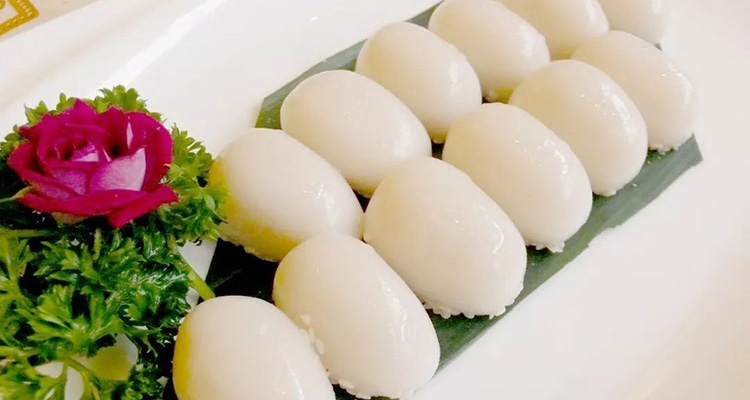Shanghai Pigeon Egg Rice Balls: A Traditional Dessert You Must Try in Yuyuan Garden
Stroll through Shanghai’s historic lanes, hear the soft Wu dialect, and smell a mix of tempting foods. Among the city’s East-meets-West culinary treasures is a delicate dessert known as Pigeon Egg Rice Balls. Resembling polished white eggs, these glutinous rice treats are not only a taste sensation but also a cultural experience. Whether you’re visiting Shanghai for the first time or returning to explore deeper, pigeon egg rice balls deserve a spot on your food map.
1. Origin and History: A Sweet Tale from the Late Qing and Early Republic
The Pigeon Egg Rice Ball originated in Shanghai during the late Qing and early Republican period, around the early 20th century. A pastry chef named Wang Youfa is credited with creating this dessert. Faced with sweltering Shanghai summers, he experimented with adding cooling mint to traditional glutinous rice snacks to make a refreshing sweet. He finally perfected a small, egg-shaped rice ball filled with a minty, sweet center. The dessert quickly became popular in teahouses and eateries across the city and has endured as a Shanghai classic.
2. Cultural Significance: Shanghai Style in a Little Bite
In Shanghai’s rich food culture, Pigeon Egg Rice Balls are more than a dessert. Their refined, miniature form reflects the city’s Haipai (Shanghai-style) emphasis on detail and elegance. Often served at the end of banquets, they symbolize a sweet, complete finish to a meal. They’re also a fixture of old Shanghai afternoon tea: a pot of tea and a few rice balls for a moment of leisure and grace. This little treat links Shanghai’s past and present, letting diners taste the city’s blend of tradition and modernity.

3. Ingredients and Craft: The Cool Heart of the Dessert
The charm of Pigeon Egg Rice Balls lies in carefully chosen ingredients and skilled technique.
Translucent outer skin: The outer layer is made mainly from high-quality glutinous rice flour. To achieve the ideal chewy, springy texture, chefs cook a portion of the flour into a paste (called jiang or sticky paste) and then mix it with raw flour before kneading. This step ensures the skin is sticky yet not gummy, smooth, and pleasantly elastic.
Cooling filling: The filling is the soul of the rice ball. Traditional recipes blend mint powder, white sugar, and candied osmanthus to create a bright, layered flavor. Mint provides a refreshing chill, white sugar adds clean sweetness, and candied osmanthus contributes a fragrant floral note. Together they produce a complex, balanced filling.
4. Preparation: Traditional Skills in Small Hands
A perfect Pigeon Egg Rice Ball involves a meticulous, multi-step process that tests a pastry chef’s skill.
- Make the sticky paste: Mix part of the glutinous rice flour with water and cook it into a translucent paste.
- Knead the dough: Combine the cooked paste with raw flour, kneading until the dough is smooth and soft.
- Prepare the filling: Mix white sugar, mint powder, and candied osmanthus in the proper ratio.
- Wrap: Pinch a small dough piece into a cup shape, fill with the mixture, and seal.
- Roll into eggs: Shape into smooth ovals resembling pigeon eggs.
- Steam: Steam over high heat until slightly translucent. Timing and temperature are key to maintaining tenderness.

5. Flavor and Texture: A Minty Ballet on the Palate
Eating Pigeon Egg Rice Balls is a sensory delight. Bite through the translucent, chewy skin and the warm, soft filling flows out. The initial coolness from mint refreshes the palate, followed by the gentle sweetness of white sugar. Finally, the floral aroma of osmanthus lingers in the aftertaste. The dessert is sweet but not heavy; the balance between the bouncy skin and smooth filling is especially satisfying on a hot day.
6. Tasting Guide: How to Eat Like a Local
When to enjoy: Usually served as a dessert at banquets or as an afternoon tea snack. Locals pair it with Longjing or jasmine tea for a refreshing contrast.
Best temperature: Eat at room temperature or slightly chilled for the best balance of chewiness and minty coolness.
Pro tip: The outer skin dries easily, so it’s best eaten fresh. Take small bites to savor each flavor layer.
7. Where to Try Them in Shanghai: Find the Most Authentic Versions
Food lovers should visit Yuyuan Garden (Yuyuan Bazaar) to find the most famous versions of this dessert.
Recommended shops:
- Green Wave Corridor (Lübolang) – a long-standing restaurant known for hosting dignitaries.
- Ningbo Tangyuan Shop – specializes in glutinous rice sweets and keeps traditional flavors alive.
Other restaurants and dessert spots across Shanghai also serve their own interpretations of the pigeon egg rice ball, blending classic recipes with modern twists.

8. Simple Home Recipe: Bring a Taste of Shanghai Home
Want to recreate this dessert at home? Try this simple version:
- Mix glutinous rice flour with warm water to form a soft dough.
- Make the filling by combining mint powder, candied osmanthus, and white sugar.
- Shape small dough balls, fill, seal, and form into oval “eggs.”
- Steam for 8–10 minutes until translucent.
It may not match a professional chef’s artistry, but it’s a fun way to taste Shanghai’s dessert culture at home.
9. Conclusion: Start Your Shanghai Food Adventure
Pigeon Egg Rice Balls are more than a century-old sweet—they capture the elegance and creativity of Shanghai cuisine. When planning your trip, don’t miss this unique treat. Visit Yuyuan Garden, enjoy it with a pot of fragrant tea, and let this delicate, mint-scented dessert become your sweetest memory of Shanghai.


